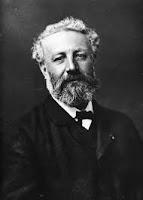 |
| Jules Verne ca. 1878 |
Jules Verne was born in Nantes, France, in February 1828. Already as a boy in boarding school he was fascinated by travels and explorations, a passion that already then inspired him to write short stories and poems. When Jules Verne went to university in Paris to study law he also made his first steps as a professional writer, but his father, a lawyer, didn’t approve of his literary ambitions. From this point Jules Verne was forced to stand on his own feet, and yet, he couldn’t but continue writing. He made his living as a stockbrocker although he hated his job, but it allowed him to marry and have a family. Jules Verne's wife encouraged him to get more seriously about writing and to try finding a publisher. At first he received many rejections, even after some of his stories and a novel had come out. Only when the publisher Pierre-Jules Hetzel recognised Jules Verne’s talent, he could begin his remarkable career in a new genre – science-fiction.
Pierre-Jules Hetzel brought out ‘Five Weeks in a Balloon’ in 1868. From then on Jules Verne published two or more books of the writer every year. Jules Verne was an amazingly prolific as well as imaginative and far-sighted writer. No less than 54 novels make up the Extraordinary Voyages series including Jules Verne’s best known works ‘A Journey to the Centre of the Earth‘ (1864), ‘From the Earth to the Moon‘ (1865), ‘Twenty Thousand Leagues Under the Sea’ (1870), and ‘Around the World in Eighty Days’ (1873). They made him famous and rich, but he also wrote short stories, essays, plays, and poems. The outlines of these widely known stories are familiar even to me. It’s improbable that any child can grow up without ever having heard of Phileas Fogg, an English gentleman, and Passepartout, his French valet, rushing around the planet within 80 days in order to win a very expensive bet. A Spanish-Japanese cartoon adaptation from 1983 is among my most vivid childhood memories.
In 1886 Jules Verne's mentally ill nephew Gaston tried to shoot him with a pistol. The writer wasn't dangerously blessed, but he kept a limp from this assault. Three years later, in 1888, Jules Verne ran for elections in Amiens, France, and became town councelor for fifteen years. Jules Verne died in 1905 at the age of 77 years. His son Michel took care of the publication of several novels that he had left. As was found out later Michel also had revised his father's stories and the original version could be published only in the 1980s.
No comments:
Post a Comment
Dear anonymous spammers: Don't waste your time here! Your comments will be deleted at once without being read.